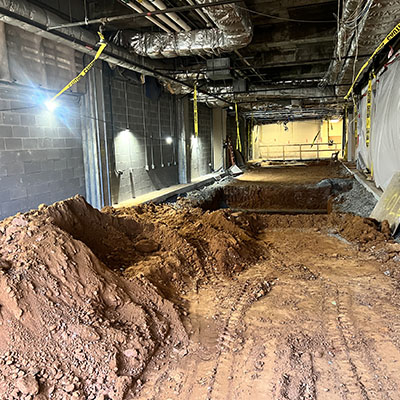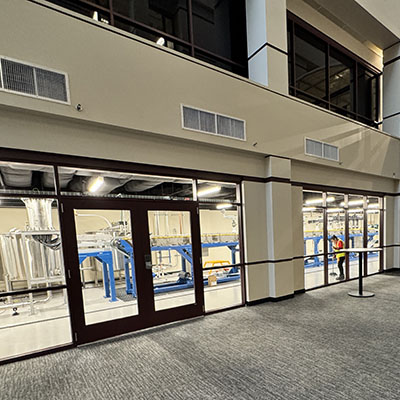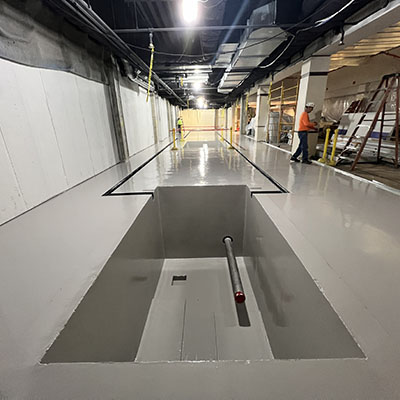Georgia Tech’s RBI Unveils State-of-the-Art Multiphase Forming Lab
May 13 marked a historic date for Georgia Tech’s Renewable Bioproducts Institute (RBI) and its home in the Paper Tricentennial Building with the grand opening of the Multiphase Forming Lab, the first significant building renovation in 30 years. Built in the 1990s, the Paper Tricentennial Building commemorates 300 years of U.S. papermaking history and supports research and education in paper science and engineering. The building houses advanced laboratories, classrooms, and collaborative spaces designed to foster innovation.
RBI, formerly the Institute of Paper Science and Technology (IPST), was originally founded in 1929 as the Institute of Paper Chemistry in Wisconsin. IPST was created to provide science, technology, and education in support of the pulp and paper industry, a rapidly growing economic sector whose leaders recognized the need for employees specifically trained in the scientific processes of papermaking.
The Multiphase Forming System, the only one of its kind in North America, significantly reduces the amount of water required to process paper. As a result, the heat and energy needed to dry the paper — typically an energy-intensive process — are also reduced. The system uses up to 70% less water, which substantially lowers the energy required for drying. This research, which began about five years ago, has drawn broad interest from industry. A more recent project, funded by Department of Energy -Office of Energy Efficiency and Renewable Energy and led by Carson Meredith, combines Multiphase Forming with the latest technologies in refining and drying.
A Collaborative Effort
The construction of the Multiphase Forming Lab was a collaborative effort that began in November 2023. Georgia Tech Senior Architect Bill Oswell partnered with Cyrus Aidun to program the space to meet the requirements of the existing grants. Georgia Tech's Infrastructure & Sustainability hired Warren Epstein & Associates Architects, BP Structural Engineering, and SSOE for the mechanical engineering and process engineering design work. Also, I&S consulted very early with E. Escher Incorporated as the general contractor. Oswell said, “We knew we needed a strong mechanical contractor on board early to vet out the pragmatic hurdles of installing an industrial machine in an office building atrium.” The design and construction phases were marked by meticulous planning and execution. The facility's layout was optimized for safe operation and state-of -the art functionality.
“Today is a milestone in RBI’s history, as we continue to partner and innovate with the paper and pulp industry,” Meredith said. “We’d like to share our gratitude with our researchers and, students; and industry sponsors International Paper, Kimberly Clark, and Solenis; and equipment partners Andritz and Valmet.”
RBI’s mission has evolved to also advance both science and engineering for the biorefining of forest and agricultural biomass. This is achieved by creating new bioproducts and biochemicals, while enhancing the value of existing renewable products and significantly reducing the cost and resource requirements of those products and processes.
To learn more about accessing the Multiphase Forming Lab, contact Hanjiang Xu.

LAND
Choosing the lab location: Originally, the lab was to be located on the third floor of the Paper Tricentennial Building. This location proved too costly to support the design and equipment and would have been disruptive to the established building activities. The basement level was selected, requiring the removal of a cafeteria, commercial kitchen and small lab.

AIR
The atrium of the RBI building serves as the return path for comfort air throughout the entire structure. The new lab location is situated directly in this return path, necessitating a design adjustment. As a result, the storefront glass system was engineered to permit return air to flow through the lab space into the adjacent mechanical room, facilitated by an upper transom without glass to ensure continuous air circulation back to the air handling system.

WATER
The original design directed wastewater from the system to the building's acid neutralization pit. However, due to potential residual pulp in the waste stream, it was deemed unsuitable. Consequently, the system was redesigned to drain directly into the sanitary sewer, utilizing a nearby, unused bathroom to modify the piping for direct wastewater pumping into the sanitary sewer.

Writer and Media Contact: Jennifer Martin | jennifer.martin@research.gatech.edu
Video: Christopher McKenney
Photos: Courtesy of Brian Doles





